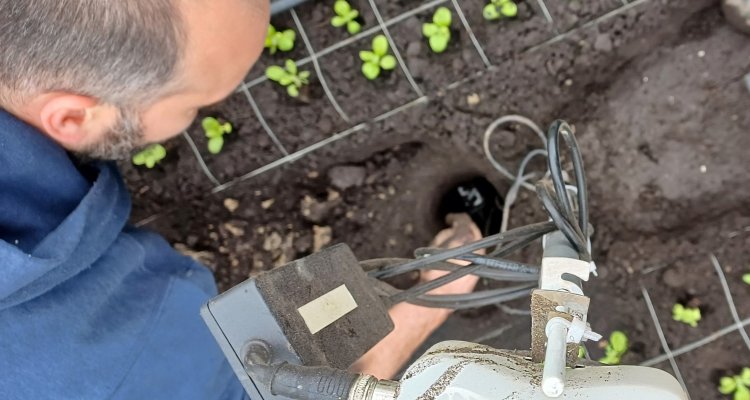
News
Virtual lysimeter calculates drain based on data and AI
Drain water may be discharged to an increasingly lesser extent in the coming years. For soil-based crops this means that growers need to know how much water the soil absorbs: they can then adjust the watering accordingly. This can be measured with a lysimeter, but that is a complex method. The Greenhouse Horticulture and Flower Bulbs Business Unit of Wageningen University & Research is working on a virtual lysimeter that works with data and sensors. Researcher Joseph Stoenner: “It is nice to see how scientific research can help growers.”
Drain water is the irrigation water that is not absorbed by the crop. This water is often rich in nutrients; that is one of the reasons that it should not be discharged. It is therefore important that growers do not give the crop too much water. With a lysimeter, a grower can measure how much water is not absorbed by the crop or held in the soil and is therefore washed out. The lysimeter is a large container of several cubic meters that is buried in the soil. The surplus of water can then be measured under the container.
A virtual lysimeter (VL) also makes clear how much drain water there is, but based on models and data. For this purpose, the VL uses data from the grower's climate computer (such as watering, radiation and heating) and a water balance model. To use the VL, samples are also taken from the soil in the greenhouse in question: at 30, 60 and 90 centimeters depth. The soil type is then examined: after all, each soil type has a different buffer function (for both water holding capacity and flow rate).
Based on all data, the VL calculates how much moisture the soil has evaporated and how much moisture the crop has emitted (through transpiration). This also makes it possible to calculate how much water is ‘left’. The virtual lysimeter has been validated at a number of cultivation companies (with different crops) that were already working with a lysimeter. This showed that the VL calculations were consistent with the actual drain.

There are now 12 growers who use a virtual lysimeter. They can log in to a website with a personal dashboard: there they can gain insight into the drain and advice on watering. Stoenner: “Science therefore contributes to how growers can do business in a sustainable and efficient manner.” The Econutri project aims to stimulate the use of virtual lysimeters as much as possible by enrolling new growers with the tool. Econutri is financed by the European Union Horizon Europe Innovation programme under the Grant Agreement No. 101081858, and VL 2.0
The VL will be further developed within the Virtual Lysimeter 2.0 project, the system is expanded with a set of sensors at a depths of 15, 45, and 60 centimeters (corresponding to the middle of each soil layer calculated by the VL): this information gives the grower extra certainty about the reliability of the measurements and advice. The Virtual Lysimeter 2.0 project is subsidized by the Topsector Tuinbouw & Uitgangsmaterialen and cofinanced and made possible by Glastuinbouw Nederland, Stichting KijK, LC Chrysant, Eurofins, Yara, LetsGrow.com, Sigrow and Quantified Sensor Technology.